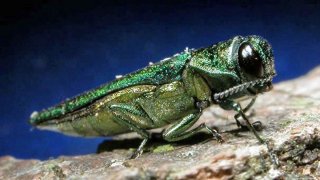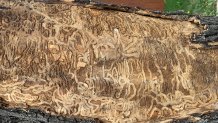
Nearly two years after it was believed to have been found in Tarrant County, the existence of an invasive, tree-killing beetle has been confirmed in Denton and Bowie counties.
The Texas A&M Forest Service began investigating reports that the emerald ash borer had been found in Tarrant County in July 2018 after a 10-year-old boy submitted a photograph of the insect to a social network focusing on nature for identification.
Entomologists confirmed the insect was the emerald ash borer, a destructive, non-native, wood-boring pest of all species of ash trees. Texas A&M's Forest Service describes it as "a significant threat to urban, suburban and rural forests, killing ash trees within two-to-five years of infestation.

With the positive identification in 2018, officials with the forest service began working with local officials to develop a plan to fight the oncoming infestation.
“Since 2018, we have deployed nearly 500 traps across Central, East and North Texas annually watching for the insect’s presence and movement,” said Allen Smith, Texas A&M Forest Service Regional Forest Health Coordinator. “Both healthy and unhealthy ash trees are susceptible to EAB attack and have no natural resistance to the exotic insect. Without forest management mortality can be 100% in heavily infested areas - so early detection could improve our chances to manage for the pest.”
Local
The latest news from around North Texas.
The EAB is green in color and smaller than a penny. The beetle bores its way into the bark of the tree and lays eggs. Larvae feed on water-conducting tissue, eventually killing the tree. The beetle has been found in 35 states, including Texas, and was first discovered in Harrison County, in East Texas, in 2016, according to Texas A&M AgriLife. It has since been confirmed in Cass, Marion and Tarrant counties.
On May 19, the presence of the EAB was confirmed to have also infested in killed ash trees in both Denton and Bowie counties, the forest service said.
- On May 15, Denton City forester Haywood Morgan collected an insect sample from a neighborhood near I-35E, and in coordination with Texas A&M Forest Service, sent it to the USDA Department Animal and Plant Health Inspection Service (APHIS) national lab for confirmatory identification.
- On May 14, in Bowie County, adult EAB specimens were caught in Texas A&M Forest Service detection traps and sent to the USDA national lab. Texas A&M Forest Service set traps and proactively monitors for the emerald ash borer each year.
As a result, the counties will now both be added to the Texas Department of Agriculture's wood transportation quarantine list, which restricts movement of any woody ash material exiting the county or quarantined area.

"Undoubtedly EAB will continue to move in and around these areas and possibly new detections will be made in other counties," the forest service said on their website. "TFS continues to monitor the movement of EAB through its trapping program and remain vigilant in evaluating potential EAB sightings across the states."
According to Smith, there is no stopping EAB, but the quarantine helps slow the beetle’s spread by restricting the movement of wood in and out of affected areas. The insect often is transported unintentionally on firewood and other wood.
Courtney Blevins, Texas A&M Forest Service Urban Forester, said in a statement Friday that, "in Denton, the urban forest has an approximate a 4% ash component, but the neighborhood where the detection was made the ash component is about 20%. Some streets much have a higher percentage and some lower, but many trees in the affected area are already infested.”
According to the forest service, ash trees make up about 5% of the DFW urban forest and about 1% of the forests in East Texas.
"There is no known stop to this epidemic," said Blevins. “But we can help communities minimize loss, diversify their tree species and contribute to the health and resiliency of their urban forests.”
The forest service said symptoms of an infestation may include any or all of the following: dead branches near the top of a tree, leafy shoots sprouting from the trunk, bark splits exposing larval galleries, extensive woodpecker activity, and D‐shaped exit holes.
Options for pre-treating trees are available. Injecting insecticide into the tree is most common, and generally effective. City leaders in Denton began discussing pre-treating trees on public property in January 2019. In an NBC 5 report at that time, city leaders said replacing the trees would cost about $100 million and that treating them seemed to be cheaper than cutting them down later.
Texas A&M Forest Service has resources available to help affected communities identify signs of EAB infestation, as well as make decisions about preventative measures they can take and how to handle tree management and removal.
Online Help
- Information on the Emerald Ash Borer from the Texas Forest Service
- EAB Photos, Resources
- TDA EBA Quarantine Info
- Think you've seen a Emerald Ash Borer? AskAnEntomologist.tamu.edu



